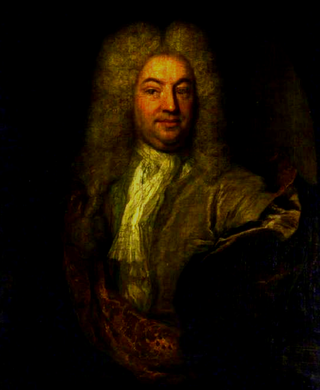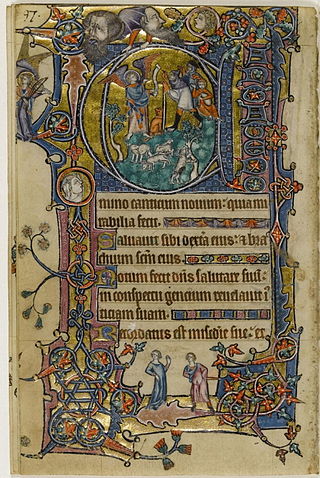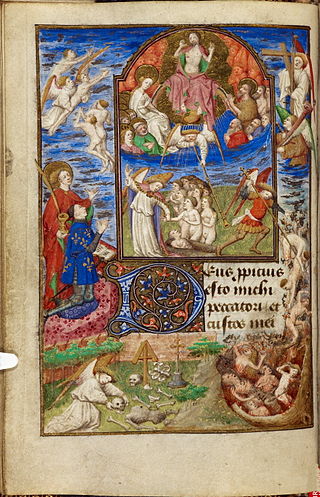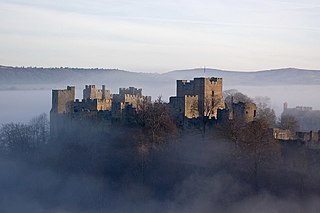
Fitzwilliam College is a constituent college of the University of Cambridge.

The Fitzwilliam Museum is the art and antiquities museum of the University of Cambridge. It is located on Trumpington Street opposite Fitzwilliam Street in central Cambridge. It was founded in 1816 under the will of Richard FitzWilliam, 7th Viscount FitzWilliam (1745–1816), and comprises one of the best collections of antiquities and modern art in western Europe. With over half a million objects and artworks in its collections, the displays in the museum explore world history and art from antiquity to the present. The treasures of the museum include artworks by Monet, Picasso, Rubens, Vincent van Gogh, Rembrandt, Cézanne, Van Dyck, and Canaletto, as well as a winged bas-relief from Nimrud. Admission to the public is always free.

The book of hours is a Christian devotional book used to pray the canonical hours. The use of a book of hours was especially popular in the Middle Ages and as a result, they are the most common type of surviving medieval illuminated manuscript. Like every manuscript, each manuscript book of hours is unique in one way or another, but most contain a similar collection of texts, prayers and psalms, often with appropriate decorations, for Christian devotion. Illumination or decoration is minimal in many examples, often restricted to decorated capital letters at the start of psalms and other prayers, but books made for wealthy patrons may be extremely lavish, with full-page miniatures. These illustrations would combine picturesque scenes of country life with sacred images. Books of hours were usually written in Latin, although there are many entirely or partially written in vernacular European languages, especially Dutch. The closely related primer is occasionally considered synonymous with books of hours, but their contents and purposes could deviate significantly from simply recitation of the canonical hours. Tens of thousands of books of hours have survived to the present day, in libraries and private collections throughout the world.

Illustrated Apocalypse manuscripts are manuscripts that contain the text of Revelation or a commentary on Revelation and also illustrations. Most of these Apocalypses were written between 1250 and 1400. Careful, the English Apocalypses are part of a larger group of Apocalypses called: the Anglo-Norman Apocalypses.

Sir Matthew Decker, 1st Baronet of Richmond Green in Surrey, was a Dutch-born English merchant and economist who served as a Member of Parliament for Bishop's Castle in Shropshire from 1719 to 1722. He was a governor of the South Sea Company from 1711 to 1712, and a Director of the East India Company from 1713 to 1743. His published works show him as "such a strong supporter of the doctrine of free trade as to rank as one of the most important forerunners of Adam Smith", proposed amongst other measures, to abolish customs duties and replace them with a tax upon houses, to abolish the duty on tea replacing it with a licence duty on households wishing to consume it, and to repeal import duties and bounties in general. At his house in Richmond, he amassed a large collection of art, including many Dutch paintings, which later formed the core of the collection of the Fitzwilliam Museum, founded by his grandson. He was a pioneer in the growing of exotic fruits in England, including pineapple and lemon, in his heated greenhouses at Richmond.

Maiolica is tin-glazed pottery decorated in colours on a white background. The most renowned Italian maiolica is from the Renaissance period. These works were known as istoriato wares when depicting historical and mythical scenes. By the late 15th century, multiple locations, mainly in northern and central Italy, were producing sophisticated pieces for a luxury market in Italy and beyond. In France, maiolica developed as faience, in the Netherlands and England as delftware, and in Spain as talavera. In English, the spelling was anglicised to majolica, but the pronunciation usually preserved the vowel with an i as in kite.

The Macclesfield Psalter is a lavishly illuminated manuscript probably produced c. 1320–30 in East Anglia. The psalter, or book of Psalms, contains 252 beautifully illustrated pages and is named after its most recent owner, the Earl of Macclesfield.

William de Brailes was an English Early Gothic manuscript illuminator, presumably born in Brailes, Warwickshire. He signed two manuscripts, and apparently worked in Oxford, where he is documented from 1238 to 1252, owning property in Catte Street near the University Church of St Mary the Virgin, roughly on the site now occupied by the chapel of All Souls College, where various members of the book trade lived. He was married, to Celena, but evidently also held minor orders, as at least three self-portraits show him with a clerical tonsure. This was not unusual: by this date, and with the exception of the St. Albans monk Matthew Paris, the only other English illuminator of the period about whom we have significant personal information, most English illumination seems to have been done in commercial workshops run by laymen.

Richard FitzWilliam, 7th Viscount FitzWilliam of Mount Merrion, Dublin, Ireland, and of FitzWilliam House in the parish of Richmond in Surrey, England, was an Anglo-Irish nobleman in the Peerage of Ireland who was a benefactor and musical antiquarian who founded the Fitzwilliam Museum in Cambridge, England, with a bequest of his library and art collection. He was also a significant urban developer in the City of Dublin. He served as a Member of Parliament for Wilton in Wiltshire, England, from 1790 until his death.

The Dunois Master, also called Chief Associate of the Bedford Master was a French manuscript illuminator believed to have been active between about 1430 and about 1465. His name comes from a book of hours made for Jean de Dunois now in the British Library. He worked in association with the Bedford Master, in whose workshop he seems to have served; scholars consider him to be the most talented of the Bedford Master's assistants. He is usually assumed to have taken over the workshop when the Bedford Master ceased to be active, or to have set up his own with some of the artists. His style is characterized by soft modeling of forms, and a fondness for pale colors and shell gold.

Milton Hall near Peterborough, is the largest private house in Cambridgeshire, England. As part of the Soke of Peterborough, it was formerly part of Northamptonshire. It dates from 1594, being the historical home of the Fitzwilliam family, and is situated in an extensive park in which some original oak trees from an earlier Tudor deer park survive. The house is a Grade I listed building; the garden is Grade II*.
The Stowe manuscripts are a collection of about two thousand Irish, Anglo-Saxon and later medieval manuscripts, nearly all now in the British Library. The manuscripts date from 1154 to the end of the 14th century.

The Kakiemon elephants are a pair of 17th century Japanese porcelain figures of elephants in the British Museum. They were made by one of the Kakiemon potteries, which created the first enamelled porcelain in Japan, and exported by the early Dutch East India Company. These figures are thought to have been made between 1660 and 1690 and are in the style known as Kakiemon. They were made near Arita, Saga on the Japanese island of Kyūshū at a time when elephants would not have been seen in Japan.

Pain fitzJohn was an Anglo-Norman nobleman and administrator, one of King Henry I of England's "new men", who owed their positions and wealth to the king.

Venus and Musician refers to a series of paintings by the Venetian Renaissance painter Titian.

The Hours of Philip the Bold is a late 14th-century illuminated book of hours produced in Paris for Philip the Bold, Duke of Burgundy (1363-1404). It contains illustrated calendars, figured initials and 11 large miniatures with ivy borders, following the Paris liturgy. The manuscript has a devotional use. Philip reportedly recited his daily prayers from this manuscript. His hours, which contains almost 200 images, is one of the most worldly manuscripts to survive from the library of the Burgundian Dukes. It is now MS. 3-1954 in the Fitzwilliam Museum, Cambridge.

Josce de Dinan was an Anglo-Norman nobleman who lived during and after the civil war between King Stephen of England and his cousin Matilda over the throne of England. He was a landholder in the Welsh Marches when he was married by Stephen to the widow of Pain fitzJohn, a union that gave Josce control of Ludlow Castle. Control of the castle was contested by other noblemen, and the resulting warfare between the nobles forms the background to a late medieval romance known as Fouke le Fitz Waryn, which is mainly concerned with the actions of Josce's grandson, but also includes some material on Josce's lifetime. Josce eventually lost control of Ludlow and was granted lands in compensation by Matilda and her son, King Henry II of England, who succeeded Stephen in 1154.
Sybil was an Anglo-Norman noblewoman in 12th-century England. Her parentage is unclear, but her first marriage to Pain fitzJohn is well attested. Through her marriage, Sybil transferred lands in several shires to her husband, including lands around Ludlow Castle and the castle itself. After Pain's death in 1137, Sybil attempted to retain control of Ludlow and her lands but in 1139 King Stephen of England married her to Josce de Dinan, who died in 1166. Sybil had two daughters with Pain, and is probably the mother of Josce's two daughters also. Sybil's marriage to Josce, and his control of Ludlow in right of his wife forms the background to a medieval Welsh romance, Fouke le Fitz Waryn.

The Rothschild Bronzes, also known as the Michelangelo Bronzes, are a pair of 16th century statuettes, each depicting a nude male figure riding a mythological animal, usually identified as a panther. Mirroring each other in pose, the nude men are distinguished by age, one young, the other bearded. The younger man is 76.6 cm, the other almost 90 cm high. The sculptures are unsigned and the figures and panthers have been separately cast. The bronzes were displayed to the public at the Fitzwilliam Museum, University of Cambridge, from February to August 2015 with an attribution to Michelangelo. If the attribution is correct, Michelangelo would have made the bronzes around 1506 to 1508, before the painting of the Sistine Chapel ceiling but after the marble statue of David. The sculptures would be the only autograph bronze works by Michelangelo to have survived.
William Charles Wentworth-FitzWilliam, Viscount Milton, was an English nobleman and politician. He served in Parliament from 1832 to his death in 1835, and was one of the youngest people to serve in Parliament in the modern era.

















